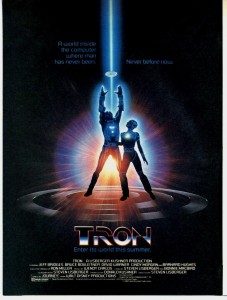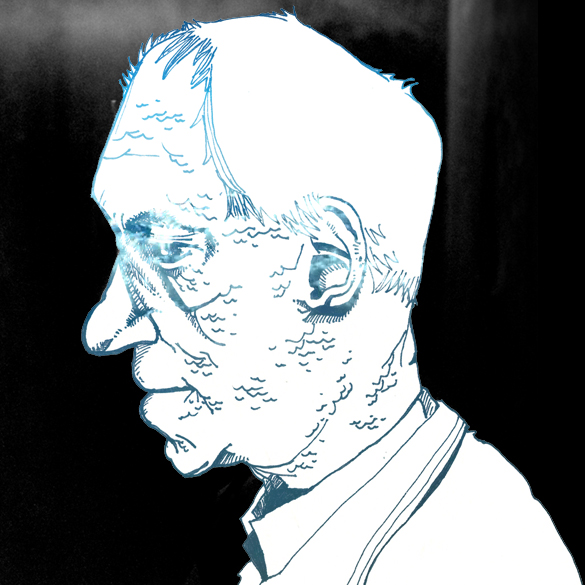As the buzz around TRON: Legacy gradually dies out, we resurrect an archived feature on its predecessor, TRON.
By Daniel Kraus (1/28/02)
 Almost two years in the making, Walt Disney’s Tron (1982) was a bona fide media event, complete with Disney’s usual array of commemorative posters, lunch boxes, action figures, T-shirts, and a promise that you would be transported to a world unlike any you’d ever seen.
Almost two years in the making, Walt Disney’s Tron (1982) was a bona fide media event, complete with Disney’s usual array of commemorative posters, lunch boxes, action figures, T-shirts, and a promise that you would be transported to a world unlike any you’d ever seen.
The difference this time around was that the promise was true— Tron WAS different. The only problem was that nobody seemed to care. Tron jumped out of the gate and landed with a thud. For the first time, Disney found themselves on the difficult “avant-guard” side of the coin as they watched Steven Spielberg’s cuddly, Disney-esque E.T. The Extra Terrestrial rake in the money. Even Tron’s hope for Oscar vindication was denied when the confused Academy said that Tron “cheated” by using computers to achieve their special effects. It was only years later that the film began to attain cult status, with young people asking each other, “Remember Tron? Wasn’t that COOL?”
It was indeed “cool,” which is why Disney gambled on it in the first place. In the early 80’s, Disney was in a major rut. This was before their renaissance with films like Beauty and the Beast and Aladdin, and Disney was simply recycling their old cartoons and releasing half-hearted Herbie films.
So when young computer animator Steve Lisberger pitched them the idea for Tron, complete with full storyboards and vivid airbrush paintings done on black paper, they were interested enough to let Lisberger shoot some test footage. The result was something intensely weird but also completely different, so Disney decided to roll the dice.
Part of Tron’s problem was that, although “computer” had become a buzzword due to the Atari game system craze, people still had very sketchy ideas about how computers worked. The entire plot of Tron balanced on the bold idea of taking non-tangible concepts (like “programs” and “on-line/off-line”) and turning them into physical and geographical realities.
Flynn (Jeff Bridges) is a computer genius who designed several great video games, only to be fired from his company, Encom, and watch the evil senior VP Dillinger (David Warner) make millions off of his programs. With the help of employees Alan (Bruce Boxleitner) and Lora (Cindy Morgan), Flynn breaks into Encom and hacks into their computer to try and retrieve evidence that the original designs were his.
As rotten luck would have it, an experimental matter disintegrator ray is pointed right at Flynn and the evil Master Control Program (MCP) zaps Flynn, sending him inside the world of the computer, where he is merely a “program.” The MCP utilizes the “game grid” (a digital gladiator arena) to force programs to battle each other to the death. Flynn finds himself fighting for his life inside of the games that he himself created.
Like The Wizard of Oz, Tron featured two separate but interconnected realities, utilizing its principle actors in dual roles. Instead of Alan, we had Tron (Alan’s new “security program”). Instead of Dillinger, we had Sark (the MCP’s main enforcer). And instead of Lora, we had Yori (who was basically just an attractive female program, but nobody said Tron’s analogies were perfect).
Tron was the perfect film for the emerging geek set, for it envisioned computer programmers as sorts of deities, shaping their own worlds and deleting them just as easily. Lisberger latched onto the growing knowledge/fear that each American was being divided into two selves. For each social security number, driver’s license, doctor’s visit, and paycheck paid, an alternate persona for each of us was growing up somewhere out there in cyberspace.
Moreover, this “alternate self” lived in a new kind of space that wasn’t Earth, the sea, the sky, the cosmos, or even the mind. It was the uncharted, theoretical realm of energy. When we turned on computers, information was exchanged, received, and stored. But how? And when we turned those computers off, where did it all go?
Tron (which is merely a truncation of the word “electronic”) bravely set out to answer those questions, and in a fun, physical way. Tron was a live-action film that nonetheless was more animated than not. The actors shot their scenes on a black stage onto black-and-white film. Then each frame of film was blown up, given color, highlights, and a CGI background. The result featured colors more vivid than anything since the heyday of Technicolor. A side effect of the process was that the actors’ faces were not only black-and-white, but also grainy and spotty, which made them look like silent film actors. This worked well with Tron, which divided its good and evil as clearly as those early melodramas—only now, the good guys wore electric blue instead of white, and the bad guys wore hot pink.
Probably the most interesting analogy in Tron is the religious one. Stuck inside the hellish world of the computer, the brave programs maintain a desperate faith in “The Users,” who they believe “wrote” all the programs. In light of the dire situation brought on by the all-powerful MCP, many programs are losing faith. Then, suddenly, Flynn—a User—is sent down from above to live among the programs, preaching to his followers that the Users do exist.
The Jesus analogy reaches its peak as Flynn sacrifices himself to save the system, turning the computer universe into a bright world of hope. If Flynn is Jesus, then he is telling his followers that, although God exists, it is up to each person to struggle to do what is right. In short, we are each in control of our own destinies.
Tron’s ideas are even more impressive today. The “MCP vs. Individual Programs” seemed to mirror the Mainframe vs. Personal Computer battle that has since occurred in real life. And concepts of the Internet were already in place, including the moral implications of the sharing of information between all Users. It’s no wonder that Lisberger is finally working on Tron 2.0.
To this day, no feature film has dared to be as visually unconventional as Tron. Unfortunately, Tron loses all narrative coherence in its final half-hour, and the action becomes increasingly difficult to follow. Therefore, despite being an impressive and daring motion picture experiment, watching Tron was like looking at a computer screen all day—after a while, you almost have to look away.
(http://www.gadflyonline.com/01-28-02/cinematimecapsule-tron.html)

